Small Wonders
The call of “catch bigger” is just about everywhere you look in the fishing world these days. We travel miles and spend small fortunes in pursuit of the big one. But be honest, did you ever secretly crave a return to simpler fishing? Did you ever miss those smaller fish and more innocent times?
We might spend whole weekends waiting for the fish that fills the net and makes our mates jealous, but for most of us it all started with the smaller stuff. A daft gudgeon, sticklebacks in a jam jar or the hordes of suicidally bold minnows my brothers would count, racking up cricket scores.
If you look a little closer, these little gems are still there to be found beneath random bridges, in village ponds, the ragged stream by the curry house or any of the other magical and haphazard spots where Dr Mark Everard is to lead us in a search for small things. It might not be macho to fish for creatures that would often fit in a matchbox, but there are entire little worlds to be discovered. Using our hands and feet, nets, strings, poles and traps we will try to find answers and perhaps even scoop a little lost youth into the bottom of a bucket.
The plan for our own mini species hunt began three summers or so ago, as I struck up a conversation with Mark having enjoyed his fascinating “Book of Little Fishes”. With both of us rather jaded at the lack of soul in so much of the current fishing scene, we decided that it would be fun to launch a specimen hunt of a very different kind.
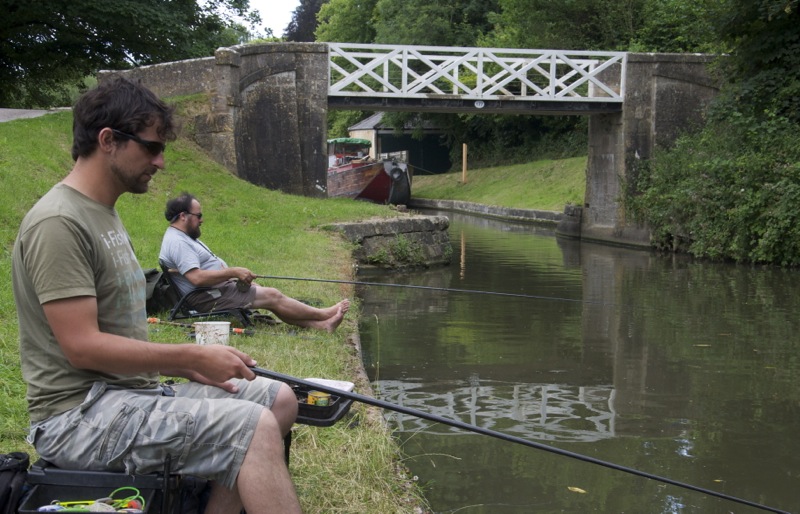
The Kennet & Avon Canal – a fine place to waste an afternoon.
Dr Everard’s house sits in a sleepy village by the Bristol Avon, and is a kind of happy-go-lucky mixture of science and anarchy. There are books, guitars and journals in droves; a poster of the Tree of Life, plant diagrams and no fewer than five fish tanks. Daisy, his teenage daughter, is lounging in the garden along with a black and white cat, as we round up minnow traps, quiver tips and tiny hooks.
Also joining us will be the General, who at just six inches tall could make even the smallest fish look like a world-beater. I enlisted him when it struck me that even the biggest ruffe or minnow wouldn’t look very impressive in my own cumbersome hands. I found the General at a car boot sale for the grand sum of twenty pence and straight away, I knew I had my man. With a camo-green uniform, outstretched arms and the fixed, joyless grimace of a true big fish angler he was the perfect candidate. But for good measure, Mark also picks out a 1960’s model Dalek for an even dafter fishing prop, both of us probably showing our level of maturity.
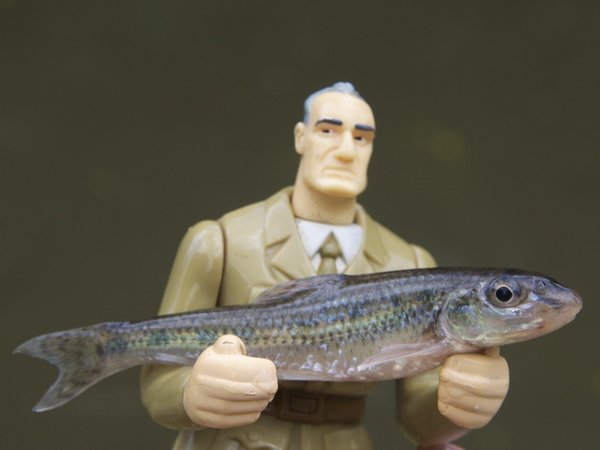
The General lands a tiny gudgeon – or is a record?
With equipment thrown in the car, our tour begins with a tiny pond beside the village cricket pitch. It is hopelessly overgrown, and the nettles sting the shit out of my legs as we look for a way in. We have a net and a bucket and are probably too excited for grown men.
“This is where it all started for me,” he says. “With sticklebacks, a branch and a worm. They grabbed hold so aggressively you didn’t even need a hook,” he reflects, as he sweeps a net in the black water.
A diminutive pond might promise little, but in effect each is its own eco system. Life finds a way, if you are a tiny opportunist like a three-spined stickleback. But in our case, the summer water level has dropped so low the task proves fruitless. I guess every specimen hunter draws a blank sometimes.
Undimmed, we make our way to the outskirts of town, where an urban stream trickles between narrow streets and parked cars. This time there is more promise, as life flickers amidst the stones. Mark plays a game of cat and mouse with a bucket in one hand and a net in the other, resembling a giant in this tiny stream, as the tiddlers flee like sparks around his feet.
Whether you are six or fifty-six, catching bullheads requires quick hands and a little strategy. A strange, speckled kind of freshwater blenny, these creatures hide on the bottom and are quick to take cover. But by lifting a stone and having a net smartly placed to intercept the fleeing bullhead, you have a chance.
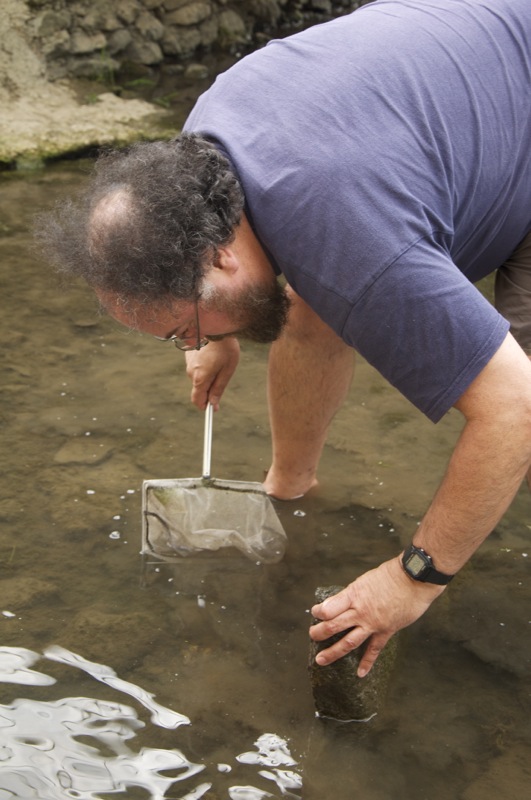
Everard the fearless hunter
In spite of its tiny size and secretive nature, the fish also known as the sculpin or “miller’s thumb” is a voracious predator with a big head and a bad attitude. By his carefully cupped hands, I know Mark has scored this time. Even in the hands of the General they are small fish, but my macro lens captures paddle fins, froggy eyes and a neatly freckled camouflage.
We also look to add a stone loach to the bucket, but these are as skinny as they are evasive and, slightly ominously, the most conspicuous residents of all here are the signal crayfish. You can find these horrible, clawed invaders in just about any hole or crevice and those we find are dutifully stomped on, not without a slightly brutal sense of relish.
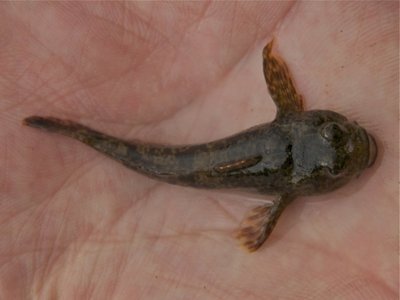
The bullhead is a nostalgic favourite
Larger signs of life await further down the road as we take a detour to the winding Bristol Avon. Mark might be a Doctor, but still has that true angler’s affliction of wanting to study and stare into every little culvert, cut, ditch and brook they come across. Beside a pillared bridge we ditch the nets in favour of light stick floats and maggots. The bites come rapidly, mostly from dace and greedy young chub. The float just keeps dipping, but we have an unusual problem for anglers: the fish are too big, we want smaller.
A bleak is our next mini-species, and not a bad one either. No great angling feat, but these are vivid little fish with a shimmer of silver, blue and green-gold. In the arms of the General, it looks like a bloody tarpon.
Other fish are also present on the river, but the most effective strategy doesn’t involve a rod, but a bottle trap positioned in the shallows. Mark has the sort of minnow catching device you last saw in a kid’s book, complete with string and bait. Left in the current for just ten minutes, the speckled little thieves come rushing in to take the bread.
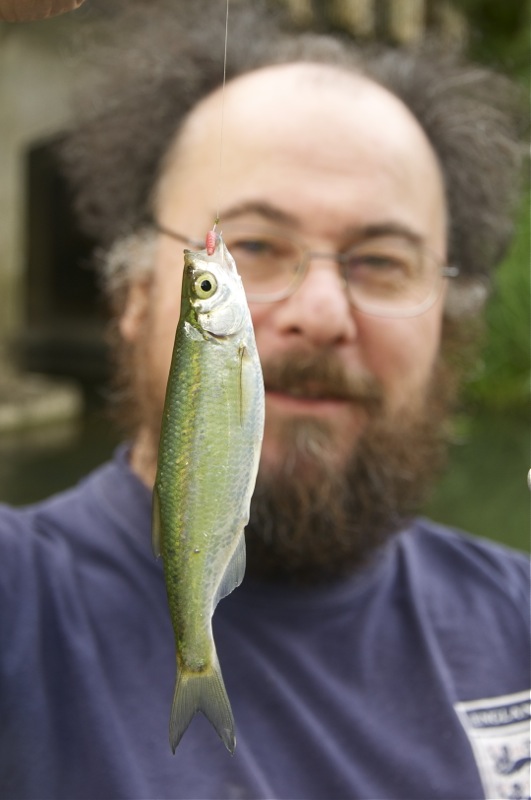
Mark admires a shimmering bleak
Cupping a hand over the hole, Mark brings up a haul of some two-dozen minnows. Some of them shoot around in alarm, while the rest just keep eating the bread. There must be literally millions of these fish in the river system, and while they might be common, they are undeniably pretty.
Our friend the Doctor actually once caught a British record minnow, although he laughs at himself at the mention of it. “I was actually playing in a band, the night before,” he says, “and it was one of those nights we were all up late after the gig. It must have been about three in the morning when I joked that I was going to catch a record minnow.”

Mark’s Dalek provides stiff competition for the General
The titanic specimen came from a cut off pond, where just a handful of minnows had escaped during a flood. With the water rich with daphnia (water fleas) and other food, the minnows had grown greedy and fat. At 15g, it was witnessed by the drummer, and joked about for weeks afterwards.
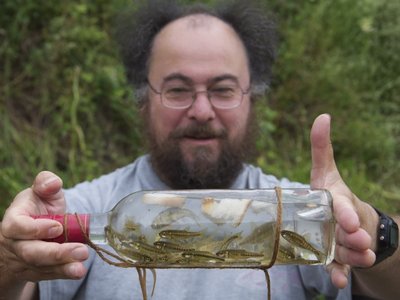
The bane of minnows – Dr Mark Everard
On a baking afternoon, we must travel further to find other small delights. But as we cast our attention wider the venue is, if anything, even narrower as we make our way to where the Somerset Coal Canal meets the Kennet and Avon. It’s a baking hot walk as we approach the soaring heights of the Dundas Aqueduct. The weather is fine and the canal looks pretty- a fact not lost on the boating parties, ice cream sellers and assorted walkers on the towpath. And into the mix, we throw pole rigs, split shot, maggots and a centrepin reel.
Our afternoon fish off will be a celebration of simplicity and variety, as testified by Mark’s lengthy answer when an old chap asks “what do you actually catch here?” The correct answer could be anything, with a couple of float fished maggots in the right place, but our spot just by the mouth of a turning bay is teeming with bleak and dace as we arrive.
Canal dace? There are so many here that the float barely settles. Nor are their bright silver and blue colours marred by the busy, murky waters here. Roach join them too, with the inevitable miniscule but devilishly greedy perch and some beautiful little gudgeon. Some of the fish look a bit on the small side even when cradled by the General or a pint-sized toy Dalek frankly, but it’s such addictively simple fun we’re not bothered.
However, what I am really hoping for is a ruffe. Not so common these days and altogether absent in my home county of Devon, these cute, perch-like fish are something of a mystery to me. But for the time being, my childish daydreams are rudely interrupted by the boat traffic churning its way through. I add a little more groundbait after every one that passes, as stag night parties drink tinned lager and accidentally smash the paint off the sides of hired narrowboats.
Mark’s Dalek provides stiff competition for the General
The little fish just keep coming regardless, for most of the day. Most of them would fit on a beer mat, with the possible exception of a flawless two-pound hybrid that makes Mark’s centrepin reel spin and the net bulge, before being derided as a “nuisance fish”.
Meanwhile, I reclaim my love of pole fishing for small fish, something I should enjoy more often. But where are these ruffe? I suggest to Mark that they have all been grilled and eaten by Romanians, presumably on very small barbeques. But eventually, another bold as you like bite for Mark results in a hoot of excitement along the bank and the magic word “ruffe!”
From the size of the thing alone we’re probably a bit overexcited. But the ruffe is more than just a runty little half-perch half-gudgeon type creature. It is a forgotten extra as far as our native species go. But what a beautiful little fish the ruffe is in the palm of the hand: a spiny, speckled creature that, in spite of its measly size, is an avid predator.
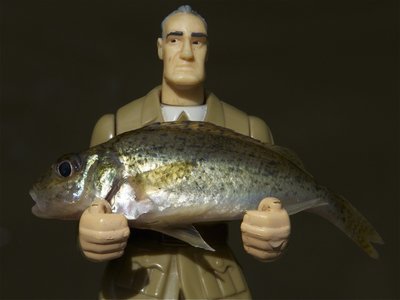
The General with a good ‘un
Aside from the odd dodgy accidental water where pike anglers have emptied a bait can, the ruffe has dwindled in many rivers and canals, suffering from environmental decline or gobbled up by the spread of zander. It is an unusual find them anywhere in the Westcountry, but on this particular canal a few ruffe managed to sneak their way into the canal among a stocking of silver fish, before quickly multiplying.
Further ruffe move in and it is soon my turn to receive a bold bite. They thump quite beautifully on light tackle and can look quite impressive, at least in the hands of a six-inch tall plastic army general. They also posses a certain, not unattractive, alien quality to my unfamiliar eye. The exaggerated mouth and eyes remind you of perch. So does the spiky fin on the back- although in the case of ruffe, the two dorsal fins are oddly fused together. The colours are rich too, if you look closer: hues of green and gold mix with silver and yellow, while the cute flecks of camouflage look as if they had been applied with a pepper shaker.
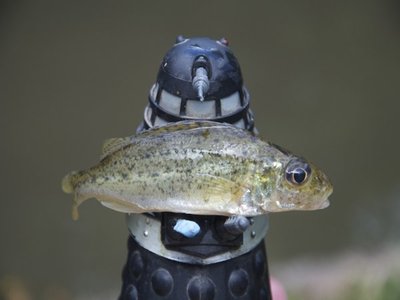
Impressive…but it won’t help him rule Earth.
The early evening is sultry as the canal gets quieter and we must think about leaving. “One more fish” becomes a mantra and as we struggle to pull ourselves away, I can’t help but wonder what happened to the fishing world of my childhood, when anglers would happily spend an afternoon catching roach, dace, gudgeon or whatever came along?
Our full day of tiddler bashing seems to have passed in a flash, perhaps like all truly enjoyable time spent on the bank. And although our catches might not be big or especially clever, we have used more methods, caught more species and enjoyed more twists, turns and detours than just about any fishing trip in my life.
Perhaps it takes something of a child’s eye, but beyond the bragging rights and the army of big fish obsessives, there are still cute corners to be discovered and an innocence that can be rekindled with the simple dip of a float.
Out Now: Crooked Lines (£9.99)
Packed with two-dozen great fishing stories, original artwork and more twists than a bucket of eels, Crooked Lines is Dom Garnett’s wildly entertaining new book. Complete with illustrations by Lord Bunn and a foreword by Matt Hayes, this delightfully different book will appeal to anglers of all persuasions.
Order your copy from www.dgfishing.co.uk or buy it as a Kindle Edition for just £4.99 from www.amazon.co.uk










